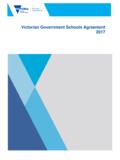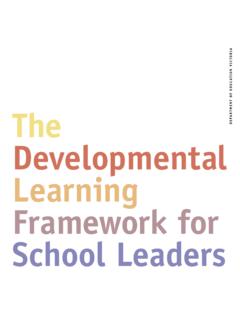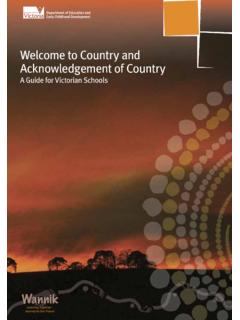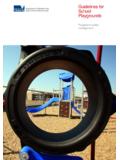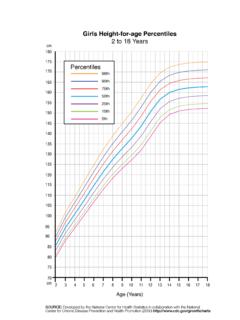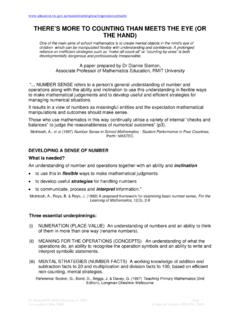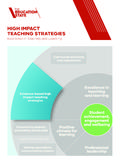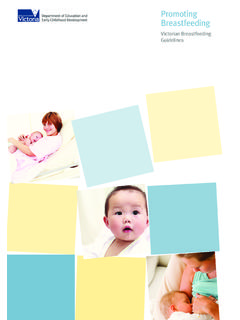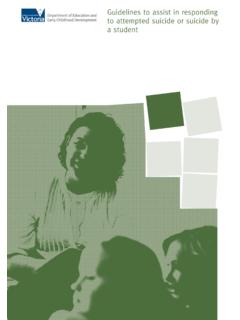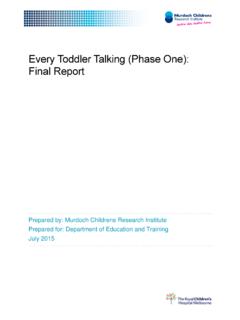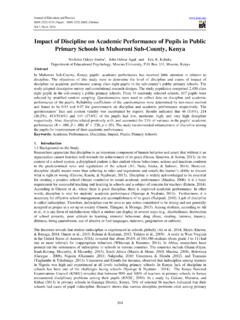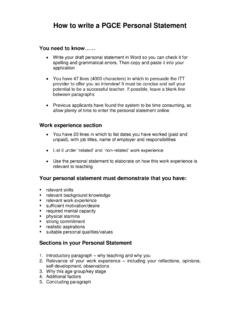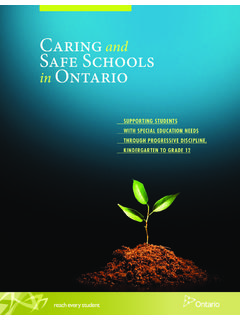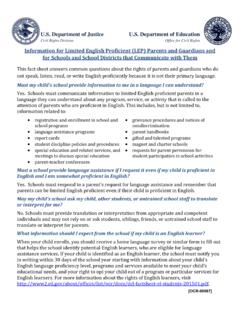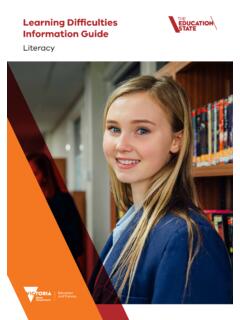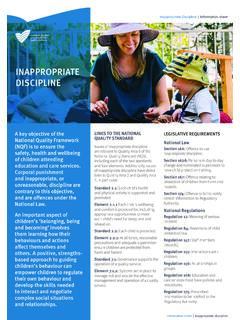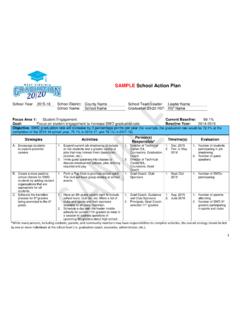Transcription of DEVELOPING THE ‘BIG’ IDEAS IN NUMBER
1 Department of Education Di Siemon: 23/01/07 Page 1 Last updated: State of Victoria 2007 DEVELOPING THE BIG IDEAS IN NUMBER One of the main aims of school mathematics is to create mental objects in the mind s eye of children which can be manipulated flexibly with understanding and confidence. A prolonged reliance on inefficient strategies such as make-all-count-all or counting-by-ones is both developmentally dangerous and professionally Prepared by Professor Dianne Siemon, RMIT University .. NUMBER SENSE refers to a person s general understanding of NUMBER and operations along with the ability and inclination to use this understanding in flexible ways to make mathematical judgements and to develop useful and efficient strategies for managing numerical situations. It results in a view of numbers as meaningful entities and the expectation mathematical manipulations and outcomes should make sense.
2 Those who use mathematics in this way continually utilise a variety of internal checks and balances to judge the reasonableness of numerical outcomes (p3). McIntosh, A., et al (1997) NUMBER Sense in school Mathematics - Student Performance in Four Countries, Perth: MASTEC DEVELOPING A SENSE OF NUMBER What is needed? An understanding of NUMBER and operations together with an ability and inclination to use this in flexible ways to make mathematical judgments to develop useful strategies for handling numbers to communicate, process and interpret information. McIntosh, A., Reys, B. & Reys, J. (1992) A proposed framework for examining basic NUMBER sense, For the Learning of Mathematics, 12(3), 2-8 Three essential underpinnings: (i) NUMERATION (PLACE-VALUE) An understanding of numbers and an ability to think of them in more than one way (rename numbers). (ii) MEANING FOR THE OPERATIONS (CONCEPTS) An understanding of what the operations do, an ability to recognise the operation symbols and an ability to write and interpret symbolic statements.
3 (iii) MENTAL STRATEGIES ( NUMBER FACTS) A working knowledge of addition and subtraction facts to 20 and multiplication and division facts to 100, based on efficient non-counting, mental strategies. Reference: Booker, G., Bond, D., Briggs, J. & Davey, G. (1997) Teaching Primary Mathematics (2nd Edition), Longman Cheshire: Melbourne Department of Education Di Siemon: 23/01/07 Page 2 Last updated: State of Victoria 2007 Four essential aspects: FOCUS ON SPEAKING Encourage children to invent and present action stories, count aloud, explain their solutions, model and acknowledge more efficient strategies. Model correct language usage, encourage the use of appropriate terminology. FOCUS ON LISTENING Model more efficient counting strategies, count on from larger, skip counting (small numbers only), count to support place-value, eg, onety-two, onety-three.
4 Twoty-one, twoty-two, ..threety-five, Listen carefully to student explanations, re-state to value contributions, use to direct teaching FOCUS ON READING Read physical collections, models, displays, adopt a say what you see approach, practice subitisation, ie, say how many without counting, teach children to read numbers, eg, 367 can be read to the tens place as 36 tens and 7 ones, read very large numbers from newspapers/magazines FOCUS ON WRITING Explore informal writing. Delay initial recording until children have access to mental strategies, expect non-modelled solutions, encourage students to record their explanations, use diagrams and symbols appropriately. RECOGNISE THAT EARLY NUMERATION INVOLVES MORE THAN COUNTING While the ability to count is important, children need to know much more before they are ready to use numbers flexibly, with understanding. NUMERATION INVOLVES: One-to-one correspondence Recognising that three means a collection of three whatever it looks like.
5 Recognising that the last NUMBER counted represents the NUMBER in the collection Matching words and/or numerals to collections less than 10 (knowing the NUMBER naming sequence). Reading, writing, and using the words and numerals for the numbers 0 to 9. BUT MORE IMPORTANTLY IT INVOLVES: Recognising collections of up to five objects without counting (subitise). Being able to name numbers in terms of their parts (part-part-whole). Trust the count (Willis, 2002) ESTABLISH PART-PART-WHOLE IDEAS FOR NUMBERS 0-10: Using a Ten Frame, for example, 6 and 1 more, 1 and 6 7 is 1 less than 8 5 and 2, 2 and 5 double 3 and 1 more 3 and 4, 4 and 3 0 and 7 Department of Education Di Siemon: 23/01/07 Page 3 Last updated: State of Victoria 2007 Use visual recognition activities involving collections, games and the use of Ten-Frames, for example, Make a permanent Ten-Frame on a white-board or felt board.
6 Use with different numbers to review what is known and extend to new numbers. Make a frame for each NUMBER on a large poster, hang it in the classroom and add relationships as children discover them. Make a class book for each NUMBER based on part-part-whole IDEAS . Make a frieze for the classroom. Make a set of NUMBER cards for the numbers 0 to ten. One set each for numerals, words, collections, different ten frames, and part-part-whole relationships (5 different sets in all). Play collection games, Concentration , Snap etc Have children sit at tables of ten arranged in pairs like a Ten-Frame. Ask: How many at the table? Send an A3 version of a Ten-Frame home to be used with fridge magnets. Encourage all members of the family to say what they see and why. Make a playground version of a Ten-Frame - have children jump in and out of the frame to make a given NUMBER in as many ways as they can.
7 ESTABLISH DOUBLES FACTS TO 20, EXPLORE MORE EFFICIENT STRATEGIES: Use 2 ten-frames, 2 rows of a bead frame, or a double-decker bus model to develop and extend doubles knowledge, devise NUMBER stories, explore strategies. INTRODUCE & CONSOLIDATE PLACE-VALUE IDEAS INTRODUCE PLACE-VALUE: Introduce the new unit - that is, ten ones is 1 ten via bundling and counting tens, eg, 1 ten, 2 tens, 3 tens, 4 tens .. Introduce the names for multiples of ten - language only, no symbols Make, Name and Record numbers 20-99 using appropriate models - eg, make 6 tens 3 ones , read and write sixty-three , record using a place-value chart Make, Name and Record numbers 10-19, pointing out inconsistency in language (should be onety-seven, onety-eight etc) Consolidate place value knowledge REINFORCE PLACE-VALUE THROUGH REGULAR ACTIVITY: Make, Name, Read and Record numbers using appropriate models Compare two numbers - Which is bigger?
8 Why? How do you know? Order and Sequence numbers Count forwards and backwards in place-value parts RENAME numbers in as many different ways as possible Department of Education Di Siemon: 23/01/07 Page 4 Last updated: State of Victoria 2007 EXTEND PLACE-VALUE IDEAS Introduce the second place-value pattern, ie, the repeated use of hundred, tens and ones, as in 356 million 356 thousand 356 (ones) - this helps with 5 and more digit numeration Ensure the patterns related to adjacent place-value parts are understood and generalised, ie, ten of these is one of those .. 1 tenth of these is one of those DEVELOP FRACTION IDEAS FROM INFORMAL, PRACTICAL EVERYDAY EXPERIENCE Review fraction language and IDEAS using discrete and continuous materials, record parts using written language, eg, 3 fifths Continuous eg, 2 and 3 quarter pizzas eg. 2 thirds of the netball court Discrete eg, half the grade to art, half to the library eg.
9 2 out of 12 eggs are cracked Evaluate foundation IDEAS , ie, recognition that equal parts required, the NUMBER of equal parts names the parts (denominator idea), and that the NUMBER of parts required tells how many (numerator idea) Involve children in partitioning start with making and naming simple, mixed common fractions using halving strategy and paper folding. Generalise to diagrams derived from paper folding techniques, for example, Paper Model Diagram derived from paper folding Extend partitioning strategies to thirding and fifthing derived from paper folding experiments and estimation based on reasoning about the size of the parts. Introduce the fraction symbol (3 out of 5). Think: 3 parts must be smaller than 2 parts 1 third less than 1 half estimate halve remaining part bank fold - three equal parts derived derived from paper-folding diagram Use Kindergarten Squares (coloured paper), plasticene, paper streamers to make and name fractions and extended range of fractions Introduce tenths via diagrams, make and name ones and tenths, introduce decimal recording as a new place-value part Department of Education Di Siemon: 23/01/07 Page 5 Last updated.
10 State of Victoria 2007 Extend partitioning techniques to develop understanding that thirds by fourths produce twelfths, tenths by tenths give hundredths Explore fraction renaming (equivalent fractions) using paper-folding, diagrams and fraction kits (where appropriate) Extend decimal fraction knowledge to hundredths and thousandths using diagrams, appropriate materials (eg, Linear Arithmetic Rods) and metric relationships, introduce percentage INTRODUCE THE FOUR OPERATIONS IN A SYSTEMATIC WAY (build from the physical to the verbal to the symbolic) CONCEPTS through action stories, modelling, make-all-count-all strategies addition: join, combine subtraction: take-away, missing addend, difference multiplication: groups of, arrays, regions, area, Cartesian product division: quotition, partition MENTAL STRATEGIES (basic facts) via visual imagery, part-part-whole IDEAS , strategies such as count-on-from-larger, doubles and near-doubles, and make-to-ten for addition, think-of-addition, make-back-to-ten for subtraction, and doubles-and-one more-group for multiplication), games and practice INITIAL RECORDING (basic facts) to support place-value and avoid = sign eg, 3 14 6 6 + 4 - 8 x7 4) 24 FORMAL RECORDING (beyond basic facts) using bundling/Base 10 materials, NUMBER expanders and mental strategies, written recording to support place-value MENTAL COMPUTATION (beyond basic facts) using place-value IDEAS and extended mental strategies, thinking strings and open NUMBER lines.
